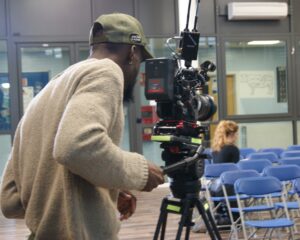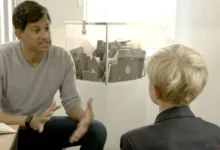Filming the Documentary
 From the very beginning, thsi project has been a pleasure to be involved in. The whole project was the brainchild of Phil Harris, CEO and Founder of BoldPrint Studios, alongside Creative Director Lou Hutchinson. As a newly establishing independent production company, SWIPED: The School That Banned Smartphones is going to be their first flagship production that is aiming to evoke social changes at the highest level.
From the very beginning, thsi project has been a pleasure to be involved in. The whole project was the brainchild of Phil Harris, CEO and Founder of BoldPrint Studios, alongside Creative Director Lou Hutchinson. As a newly establishing independent production company, SWIPED: The School That Banned Smartphones is going to be their first flagship production that is aiming to evoke social changes at the highest level.
The Stanway School was approached in June 2024 by BoldPrint Studios to work with them and put together this project about Smartphone usage in young people. The team rapidly built up a very interesting project that would be rapidly compiled to ensure that the documentary is current and leading teh way prior to any changes being made bu the UK Government next year through the Online Safety Bill that is projected to be in place from mid-2025.
 The filming of the documentary involved a small crew of people that would quickly become “part fo the furniture” at The Stanway School. The staff and students made great friendships with everyone from BoldPrint Studios and it enabled a very open and frank documentary to be filmed.
The filming of the documentary involved a small crew of people that would quickly become “part fo the furniture” at The Stanway School. The staff and students made great friendships with everyone from BoldPrint Studios and it enabled a very open and frank documentary to be filmed.
From the school, Mrs Braniff and Mrs Wadsworth coordinated the programme, ensuring that the wellbeing and safety of students was paramount at all times. This involved many conversations with families, consent forms being signed and regular check ups with everyone involved. Ahead of the filming, the students and staff who were going to be involved had welfare pre-production checks to ensure that they were suitable for the experiment and families were kept fully informed of every stage of the production. During the experiment, Mrs Braniff and Mrs Wadsworth helped coordinate the anonymous pupil survey that would be completed by over 1000 students, the largest single poll about Smartphone usage in young people that has ever een conducted in the UK.

SONY DSC
At the end of the filming, the crew left and embarked upon the huge task of editing the hundreds of hours of footage gathered into two 48 minute programmes that would be the basis of the documentary. The finished product is a real pleasure to watch and will hopefully open up the national debate into the safety of Smartphones for young people.













